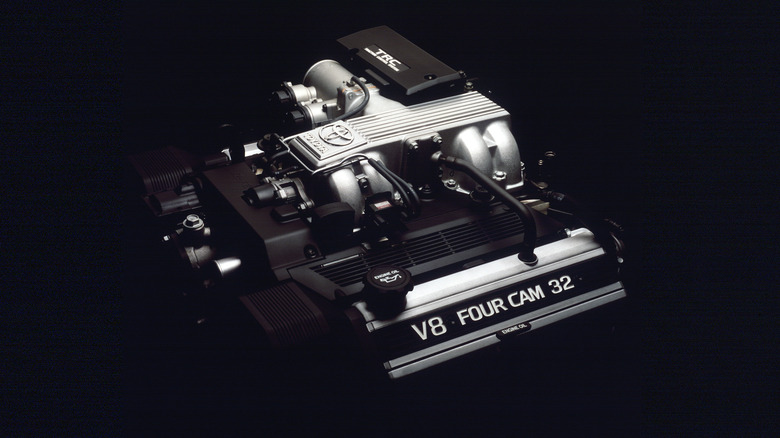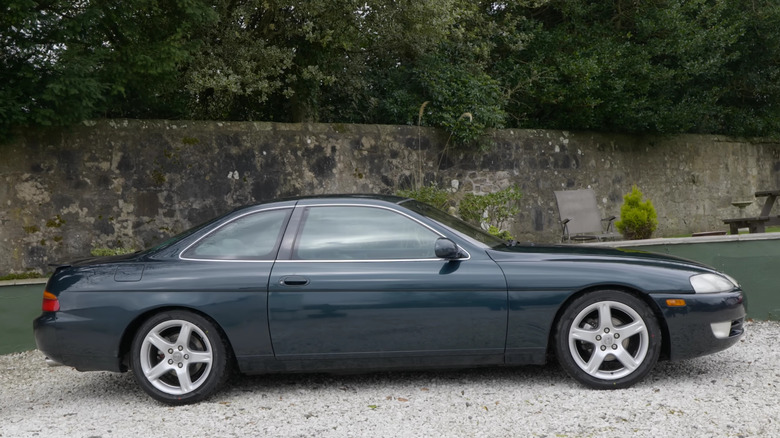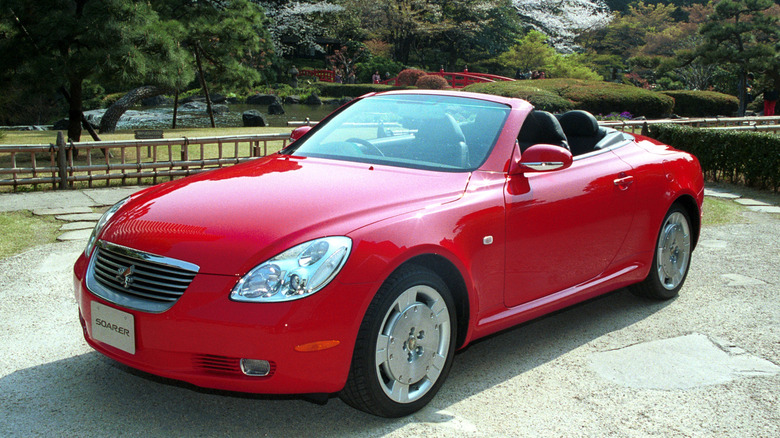5 Reasons Drivers Want The Toyota Soarer Back
The elusive grand tourer. A car that combined speed and luxury to give you the quickest, most comfortable ride from point A to B. Unfortunately, grand tourers are notoriously expensive, so most of us can never afford one. But back in the day, non-luxury automakers also had grand tourers on their menu. Particularly, Japanese automakers were crazy about competing in the highest echelon. Mazda had the sleek Eunos Cosmo. Subaru wowed everybody with the eccentric SVX. Nissan competed with the cool Leopard (Infinity M30 stateside).
However, no JDM grand tourer captivated the enthusiast scene as much as the Soarer. Designed to be Toyota's high-end vehicle, the Soarer was always equipped with the automaker's most powerful engines, most advanced suspension systems, and best tech available. Yup, just like Lexus cars today. In fact, the third and fourth generation Soarer were the same cars as the Lexus SC 400 and SC 430 sold in other markets.
There are other, more important reasons why drivers want the Toyota Soarer back. Spanning four generations, Toyota's rear-wheel-drive, luxury grand tourer became a sort of automotive icon, and in this piece, we'll explain why.
Legendary Engine Lineup
Few car models, if any, can claim to have such a legendary engine lineup as the Soarer. That's especially true for the third-gen model, which was equipped with the 1JZ-GTE twin-turbo straight-six, 2JZ-GE naturally aspirated straight-six, and 1UZ-FE naturally aspirated V8.
Let's start with the twin-turbo six-cylinder, because it's one of the most popular JDM engines in the tuning scene. Built to the same standard as its bigger brother, the 3.0-liter 2JZ-GTE, this 2.5-liter can handle over 500 horsepower with the stock block. Even from the factory, it produced 280 horsepower and 268 lb-ft of torque, both excellent figures. Crucially, the 1JZ-GTE-powered Soarer was super-reliable, with the engine easily lasting for over 200,000 miles with regular maintenance.
The 4.0-liter 1UZ-FE V8 is even more special if you don't care about tuning. It's the same engine found in the first-gen Lexus LS 400, one of the world's most reliable V8s. Don't mistake reliability for simplicity, as the 1UZ-FE was also one of the most advanced engines of its time. It had a reinforced aluminum block with six cross-bolted main bearing caps and cast-iron cylinder liners. Toyota threw all the best parts in this overengineered gem.
Older Soarers also had some legendary engines onboard. The second-gen model came with the 1G-GEU 2.0-liter straight-six co-developed with Yamaha, and the tunable 3.0-liter twin-turbo 7M-GTEU, good for 230 horsepower from the factory. Later, Toyota equipped the coupe with its first twin-turbo straight-six engine, the 1G-GTE, which produced 210 horsepower from a mere 2.0-liter capacity.
Unique Fusion of Performance, Luxury, and Reliability
As a class of cars, grand tourers have always been about providing their owners with a blend of speed and luxury. The idea is to cover long distances quickly and in utmost comfort. However, you'll only get the ultimate luxury/performance combo in the most expensive grand tourers, from companies like Mercedes-Benz, and Aston Martin.
Although it only wears the Toyota badge — or Lexus outside of Japan — the Soarer definitely belongs to that club. Equipped with the 2.5-liter twin-turbo 1JZ-GTE and five-speed manual, the third gen reached 62 mph (100 km/h) in just 5.8 seconds and had a top speed of 157 mph (252 km/h). The 4.0-liter V8 wasn't to far behind, reaching 62 mph in 6.3 seconds when equipped with four-speed automatic transmission.
The Soarer wasn't covering ground quickly only in a straight line — it was good in the corners as well. Thanks to its excellent handling balance, the Soarer is one of the best drift cars ever made. Although big and heavy, the Soarer is agile through the corners — fun to drive, even. Higher-end models were even equipped with 4WD (four-wheel-steering) and an electronically controlled air suspension. On top of that, the high-quality cabin remained quiet at speed.
The Soarer also had something that other grand tourers lacked — reliability. With such a renowned lineup of reliable engines, the Soarer was of course bulletproof. Both the straight-six twin-turbo and V8 can go well over 200,000 miles without a rebuild, and don't have glaring reliability issues.
Very Advanced for its Time
You'd think that a car with that much focus on reliability would've been quite primitive. Still, each generation of the Soarer was one of the most advanced vehicles globally when launched. For instance, the first-gen model came with a microchip-based automatic air conditioner in 1981, featuring a digital speedometer and LED tachometer. In 1985, Toyota introduced the Electro Multivision instrument panel with a built-in CRT screen, which cycled between different submenus, just like in modern vehicles.
The second-gen 1986 Soarer went even further and introduced the world's first "space vision meter" instrument panel, which projected the image at a distance to make it easier for the driver's eyes to adjust. The top 3.0GT Limited model was also equipped with TEMS (Toyota Electronic Modulated Suspension) with air suspension. Furthermore, introduced in 1989, the Soarer Aero Cabin offered the ultimate open-air ride with a retractable hardtop.
Still, the third-gen Soarer was easily the most advanced. Notably, it was the world's first car with a backup camera in 1991, which only recently became a standard feature on modern vehicles. The 6.0-inch full-color display was also used for the built-in GPS navigation. Another unique feature was the ultrasonic door mirrors, which used ultrasound to clear the mirrors from water droplets. The hydro-pneumatic Active Control Suspension was also cutting-edge for its time. The third-gen Soarer was even equipped with the world's first active four-wheel steering, which used information from the yaw-rate sensor to keep the car stable at speed.
Project Car and Tuning Potential
The fantastic engines, reliable mechanics, and nimble chassis all point out one thing — the Soarer is an excellent project car. Put simply, people are modifying these grand tourers to an amazing extent. You can, for example, easily tune the 1JZ-GTE engine, but you can also cram Supra's special 2JZ-GTE engine under the bonnet for crazy builds with up to 1,000 horsepower. The 2JZ-GTE enjoys excellent aftermarket support, so finding parts that add power is a breeze.
The 4.0-liter V8 is also no slouch when it comes to tuning potential. Thanks to its displacement, it can produce excellent power in a naturally aspirated form — excellent news for the non-turbo purists. For instance, the V8 can produce 350 horsepower at the wheels with a different cam setup. It will sound like a muscle car, too. Of course, you can go the forced-induction route and push almost 550 horsepower at the wheels.
Soarer's versatility is also a huge advantage over similar grand tourers. Since it shares most suspension parts with the Supra, it's easy to change the handling characteristics with aftermarket components. Want a Soarer drift car that will rip the back tires? Or maybe a Soarer track machine to attack the Nürburgring? The Soarer can do both — no matter if you are building a project car for fun or competition. Few — if any — luxury grand tourers are as versatile. Aston Martin, Jaguar, or even Mercedes-Benz shouldn't be even put in the same sentence with "project car."
It Had no Direct Replacement
Although the third-gen Soarer is the most popular among enthusiasts, the model did receive a successor in 2001. The fourth-gen Soarer is the same car as the Lexus SC 430 sold stateside. The focus with this model was also different. This was not a performance-oriented grand tourer, but a luxury convertible. Some even consider it the worst car in the world, though we wouldn't go as far. In fact, it's a fine open-top luxury vehicle with a smooth, super-reliable 4.3-liter V8. Still, it was never designed to stir the soul, which might be the biggest reason why Soarer enthusiasts overlooked it.
Once production of the Soarer convertible stopped in 2005, though, a successor never arrived. Yes, the Japanese giant re-introduced the Supra, but that's more of a sports car — not a grand tourer. Perhaps the closest car to the Soarer is the stunning Lexus LC 500 convertible. It looks like a concept car, has a sonorous 5.0-liter naturally aspirated V8, and a fantastic interior. Still, the V8-powered Lexus isn't very tuner-friendly. The engine is generally reliable and can be tuned, but it's not as straightforward as the 1JZ or 2JZ engines.
Could Toyota introduce a tunable, enthusiast-grade grand-tourer in the future? Highly unlikely. If it does, it will almost certainly carry the Lexus badge. Fortunately, Toyota will soon launch a brand-new, performance-oriented 2.0-liter turbocharged four-cylinder. The G20E will produce 400 horsepower in stock form or 600 horsepower in motorsport tune.





